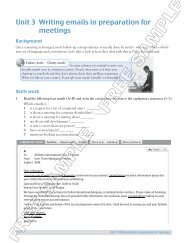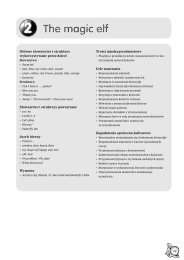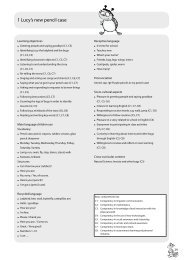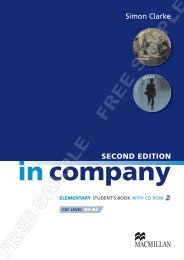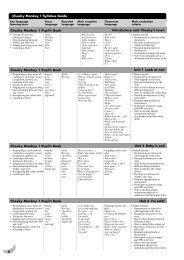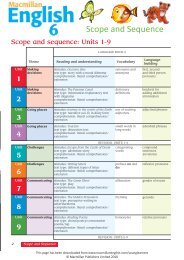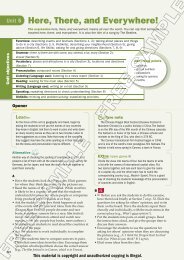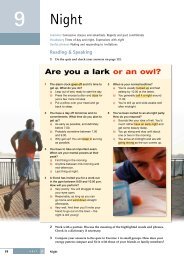fr eesamp le fr eesamp le - Macmillan
fr eesamp le fr eesamp le - Macmillan
fr eesamp le fr eesamp le - Macmillan
You also want an ePaper? Increase the reach of your titles
YUMPU automatically turns print PDFs into web optimized ePapers that Google loves.
52<br />
A<br />
D<br />
B<br />
C<br />
E<br />
Znajdź poniższe słowa (1–8) w słowniku<br />
angielsko-polskim. Następnie przeczytaj<br />
teksty o pięciu niezwykłych roślinach (A–E).<br />
1 trap __________________<br />
2 insects __________________<br />
3 touch __________________<br />
4 thirteen thousand __________________<br />
5 horrib<strong>le</strong> smell __________________<br />
6 move __________________<br />
7 eat __________________<br />
8 can’t __________________<br />
Amazing plants<br />
Niesamowite ro ˘sliny<br />
The Venus flytrap (muchołówka)<br />
is <strong>fr</strong>om the United States. It’s<br />
got small flowers and small<br />
<strong>le</strong>aves. The <strong>le</strong>aves are a trap for<br />
small insects. They close and the<br />
insects can’t move. Small insects<br />
are food for this plant!<br />
This small oak tree (dąb) is in<br />
California, in the United States. It<br />
isn’t tall, but it’s very, very old. It’s<br />
about 13 thousand years old!<br />
This is the titan flower (dziwidło<br />
olbrzymie). This plant is <strong>fr</strong>om<br />
Indonesia. The flowers are very, very<br />
big and they’ve got a horrib<strong>le</strong> smell!<br />
This is the sensitive plant<br />
(mimoza wstydliwa). It’s <strong>fr</strong>om<br />
South America. It’s a very small<br />
plant and it’s got small flowers.<br />
When you touch it, the <strong>le</strong>aves<br />
close.<br />
This is the dancing plant (tańcząca<br />
roślina). It’s <strong>fr</strong>om China. It isn’t big<br />
and it’s got small flowers. This plant<br />
can dance. When you play music,<br />
the <strong>le</strong>aves move.<br />
Plants<br />
Rozwiąż quiz profesora. Za każde poprawne<br />
rozwiązanie otrzymasz 1 punkt.<br />
1 This plant eats insects. ___<br />
2 These plants have got small flowers. ___<br />
3 The plant is very, very old. ___<br />
4 This plant has got a horrib<strong>le</strong> smell. ___<br />
5 This plant has got very big flowers. ___<br />
6 This plant is <strong>fr</strong>om China. ___<br />
Przeczytaj opis tajemniczej rośliny i uzupełnij<br />
tekst.<br />
Name:<br />
From:<br />
Flowers:<br />
Leaves:<br />
Food:<br />
O których roślinach mowa<br />
Przy każdym zdaniu wpisz<br />
odpowiednią literę (A–E).<br />
Giant Pitcher Plant<br />
the Philippines<br />
big<br />
big (a trap for big insects)<br />
big insects<br />
The _____________ is <strong>fr</strong>om the _________.<br />
It’s got _________ flowers and _________ <strong>le</strong>aves.<br />
The <strong>le</strong>aves are a trap for _________ insects.<br />
_________ insects are food for this plant!<br />
Rozwiąż drugi quiz profesora. Za każde<br />
poprawne rozwiązanie otrzymasz 2 punkty.<br />
Niektóre państwa, oprócz<br />
flagi i godła, posiadają też<br />
symbo<strong>le</strong> w postaci kwiatów.<br />
Czy potrafisz wyszukać nazwy<br />
kwiatów – symboli ponższych<br />
państw<br />
1 Poland ___________<br />
2 England ___________<br />
3 The United States ___________<br />
4 Scotland ___________<br />
5 Ireland ___________<br />
FREE SAMPLE FREE SAMPLE




